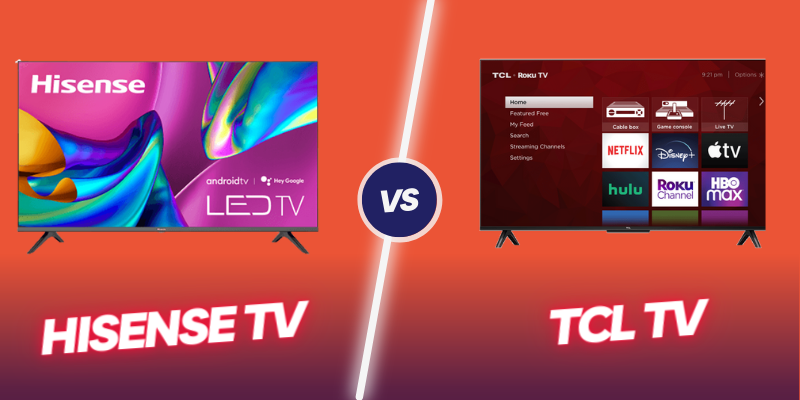
When shopping for a new TV, some people may recommend well-known brands like Samsung or LG, but these can be costly and not within everyone’s budget.
Instead, other options offer high-quality TVs at more affordable prices, such as Hisense and TCL.
Hisense and TCL are popular Smart TV brands known for their affordable prices and impressive features. But with so many options, deciding which is best for your needs can be challenging.
In this article, I will make a neck-to-neck comparison of Hisense vs. TCL!
Hisense vs. TCL: A Short Summary!
Short Version
If you’re trying to pick between a TCL and a Hisense TV (under $600), go with the TCL.
Personally, I will go with TCL TVs any day for these reasons:
- Image Quality: They provide greater color accuracy, clarity, motion management, and fantastic response time, which affect image quality.
- More Affordable: TCL TVs are more affordable than Hisense TVs, making them a budget-friendly alternative.
- Operating System: Another benefit of TCL TVs is that they utilize Roku for streaming, which is more user-friendly than Hisense’s Android TV.
Overall, TCL TVs are an excellent alternative to expensive known brands for those who are searching for affordable smart TVs packed with features. While comparing a Hisense and TCL TV with similar prices, TCL will always get ahead because of its color quality and product design.
With that said, Hisense and TCL both provide excellent televisions that are best for your money. You may choose between these two manufacturers when looking for an inexpensive 4K television.
Though unlike TCL, Hisense also provides OLED televisions, which are a bit on the expensive side.
Which TV do you need to Buy?
As of now, you sure know which is my favorite out of these two, but the case doesn’t end here because it’s all about personal preference!
So let’s discuss some factors you should consider while choosing one of these two brands.
Both Hisense and TCL have a wide selection of televisions, from budget to high-end options.
Although Hisense and TCL target the entry-level and mid-range markets in the smart TV industry, they also offer high-end 4K 85″ TV models that compete with other luxury brands like Samsung and LG.
Hisense and TCL brands start their TV sizes from 32 inches in the US market and go up to 85 inches. Things start to get serious when I found that both of these brands source their screen panels from the same manufacturers.
The differences between Hisense and TCL are so minimal that I had to finalize my decision on the product design, affordability, and operating system.
So, how did I decide that TCL is the winner of this category? Why do I say that TCL TVs are better? The answer is simple!
Well, for most of it, personal preference! But things also help when you know the key differences! These differences are so minimal that you might never have noticed before.
I am going to talk about every feature of Hisense TVs and TCL TVs, from TV size, operating system, image quality, price, and everything else, so you can decide which TV you should buy.
Operating Systems Comparison
Comparison between the operating systems is a must, and the operating system plays a crucial part in a smart TV choice. The Hisense TV uses Google Android TV OS, while the TCL uses Roku TV.
1. Hisense Google TV OS
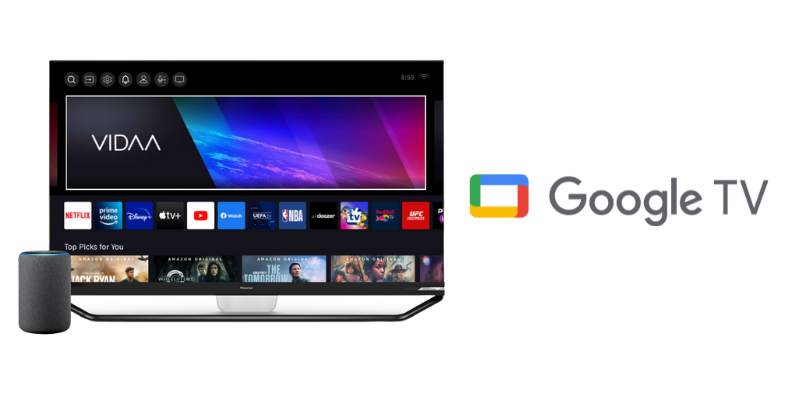
Hisense used the newly launched Google’s Android TV in most newly released Smart TVs. They used to have their own VIDAA operating system, which they don’t provide in the latest releases anymore because of less demand.
In the past, Hisense also released some TVs with the Roku TV operating system, but they weren’t that successful, so Hisense discontinued them.
The best thing about the Android Operating system is its user base and the developer’s dedication to the project! The operating system keeps up to date so that you can enjoy the latest applications. With that said, you will always get priority access to most applications as the devs prioritize Android releases.
While I talk about smart TV applications, Hisense allows you to access Play Store, which further helps you access a wide range of TV applications, and it is so easy to download and install apps in Hisense OS, thanks to Play Store.
Another best thing about Hisense TV is a built-in Chromecast module, which allows you to cast hundreds of streaming applications directly from your smartphone or PC.
2. TCL Roku TV OS
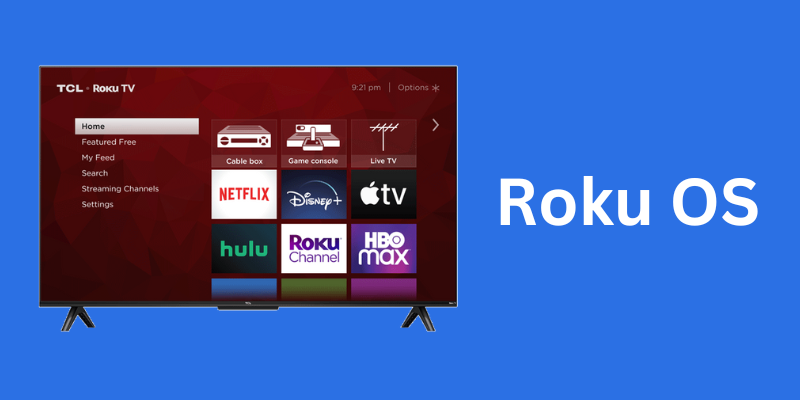
Most TCL models come with the Roku TV operating system, though they also started releasing new TVs powered by Google TV.
Roku was probably the first operating system that was designed for streaming media on a TV. They are partnered with well-known streaming brands like Hulu, Netflix, Apple TV, Amazon Prime, and many others. Besides that, Roku allows users to access a vast library of premium and free channels.
There are specific applications yet to be released on Roku OS, while Android TV already has them.
Instead of a built-in Chromecast, Roku powers Miracast. Miracast is another casting module that allows you to cast from your phone, but not that reputed in the market. (I prefer Google’s Chromecast.)
Since Miracast is natively built-in to Windows, you can mirror your PC to your TCL TV if you want!
What I like about Roku TV OS is its user interface and responsiveness compared to an Android TV. It is clutter-free and only shows you the apps you frequently use, while Android TV throws every single application on the homepage, making it slow and buggy.
3. Which OS are you choosing?

So it ends on personal preference!
- Hisense Google TV: If you want a TV that adds up every newly released application in days but has a very cluttered UI, go with Google TV and choose Hisense!
- TCL Roku TV: If you are not subscribed to many streaming apps, and you can wait for newly released applications for months but want a clean user interface that is extremely fast compared to others and much more responsive, go with TCL Roku TV.
Please also remember that while choosing between a Hisense and TCL, you would also choose Chromecast or Miracast. Though I use TCL, I bought the Chromecast stick, which fixed my issues with Miracast.
The newly released models from TCL feature Chromecast, but if you are going for an old budget-friendly model, you might have to buy a casting stick.
Streaming Stick is a Solution
At the end of the day, the operating system is not the ONLY deciding factor between a Hisense and TCL TV. This is because you are not restricted to using only one specific OS.
If you are going with TCL TV because you prefer the Roku operating system but want to have Chromecast instead of Miracast, you can buy a dedicated Chromecast stick for your TCL TV.
You can even buy Roku TV Stick for your Hisense TV to have more than one operating system in a single TV.
So, these streaming sticks really terminate a TV’s preference over the operating system factor only.
Built-in Speakers Sound Comparison
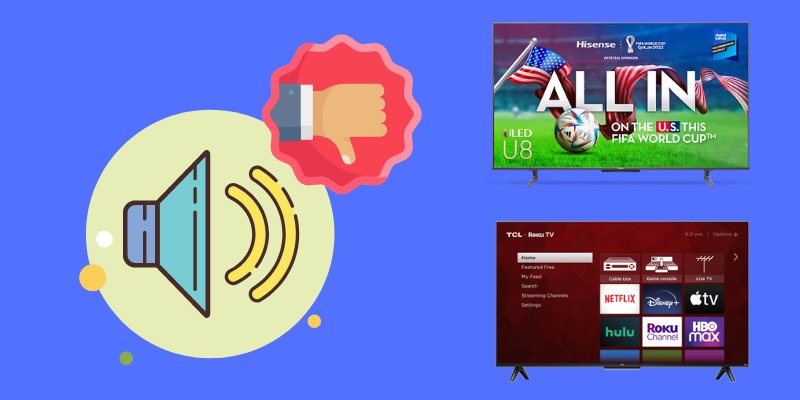
The Hisense comes with probably the worst speakers in any TV brand. TCL’s built-in speakers are not that good, but they are miles ahead of Hisense!
Though I always prefer to buy external speakers or a soundbar to go along with your Smart TV to have a wonderful experience.
Screen Panel Comparison
When it comes to buying a TV, the TV screen plays the most crucial part!
In the entry-level and mid-range areas, Hisense and TCL go neck-to-neck, but in the high-end market, Hisense takes the lead because it offers OLED TVs, which TCL is not as of now. (TCL is planning to release OLED TVs in mid-2023.)
But the thing is, we go with Hisense and TCL because of our low budget, and we rarely buy these high-end models from these brands. We just go for these brands when we plan to buy an inexpensive 4K TV with a decent size.
With that in mind, let’s have a deep dive.
1. Image Quality
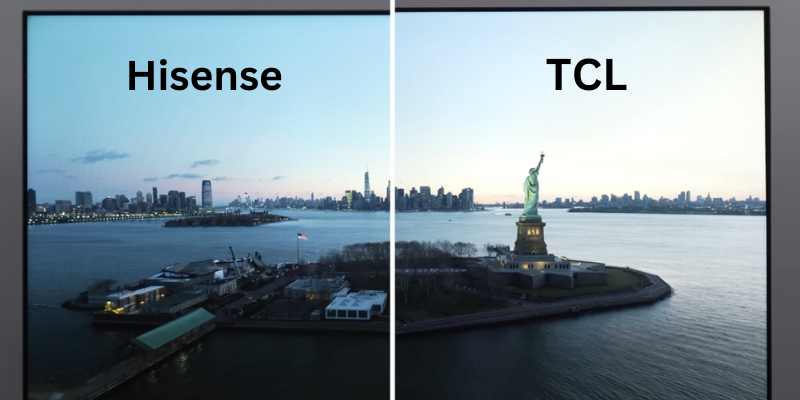
If you compare a Hisense TV and a TCL TV with the same price, same screen size, same launch years, side-by-side, the TCL’s image quality feels superior and much more natural than Hisense.
I have no idea how they manage it, it could be from their color settings or maybe because of the panel quality, but their picture quality is better.
However, these differences are so minimal that you wouldn’t even notice if you were not focusing. If you jump from a 1080p TV to 4K, you will find both brands fascinating!
Hisense also has the upper hand in premium models, as they compete with TCL by providing 8K TVs, while TCL does not.
2. Brightness
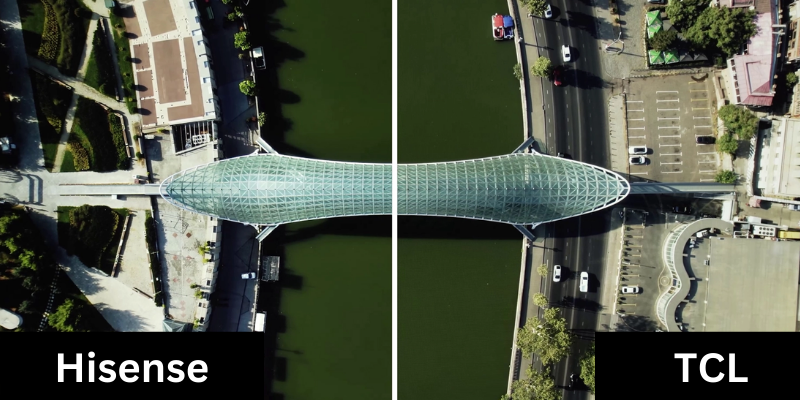
Hisense offers a peak brightness of up to 2000 nits, while TCL offers up to 1925 nits in their most premium category.
So, Hisense is the winner when it comes to brightness!
Although brightness is not crucial in choosing a TV, it helps only in the daytime. The flaw in Hisense brightness is the panel oversaturates the bright areas.
TIP
If you love to watch your TV shows and movies in the daytime with open curtains (you sound a bit weird, though), Hisense is a good option!
3. Black Depth
Because of OLED technology, the darker blacks make the dark scenes more vivid and pleasing to the eyes.
TCL is nowhere close to Hisense’s black depths in the premium category! If you buy a TV worth more than $1000, go with Hisense OLED TVs, you will never regret it!
Even Hisense UHD TVs offer better black levels than TCL UHD TVs, but if you are paying a premium price, OLED is a go-to choice!
In the entry-level and mid-range zones, TCL offers better black depth. So, if you buy a TV for under $500, TCL is better! Rest you can go to the stores and have a user demo to know better which one you prefer.
4. Colors Accuracy
Color accuracy is an essential factor to consider while choosing a TV because of these reasons:
- Poor color accuracy may lead to washed-out images.
- Inaccurate colors will distort the visuals, which can spoil your viewing experience.
Compared side-by-side Hisense and TCL, TCL TVs are better in color accuracy on their default color profiles.
You can also search for YouTube videos that will help you color-calibrate your display to have better TV colors.
5. Image Clarity
TCL TVs are a bit better than their Hisense equivalents.
You will need to put the TVs next to each other in order to see the differences in image clarity between them.
Although Hisense’s clarity is also quite good, the clarity offered by TCL is somewhat superior in this regard.
6. Local Dimming
By lowering the brightness of some regions of the screen’s backlight, LED TVs can increase the contrast ratio in low-light settings. This enhances the quality of the image by making the blacks look darker than they would be without the feature.
Since we have discussed above how good the black levels are on Hisense panels, Hisense takes the lead here too.
Though the results are extremely similar in the budget zone, in the premium category, Hisense doesn’t let TCL stand even close to them.
Remote Control
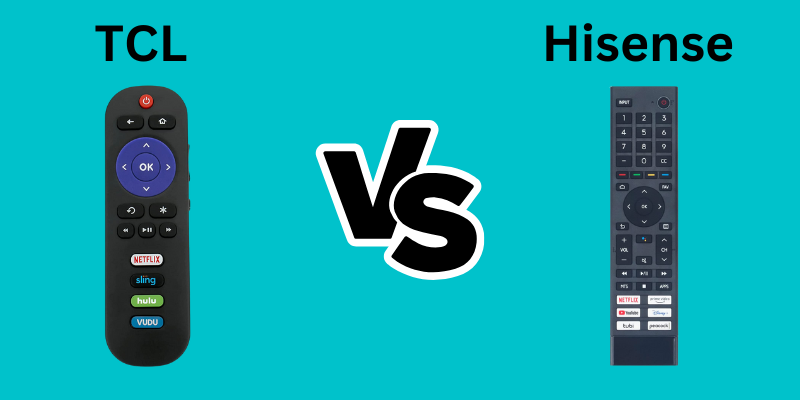
The remote for a Hisense TV is often bigger and more feature-rich than a TCL TV. (At the same time, I find it to be more cluttered.)
The voice-activated functions of a Hisense TV are often accessed through a button on the remote specifically designated for usage with Google Assistant. There’s a numeric keypad and some shortcuts to your favorite media applications.
TCL remotes follow the Roku standard of minimalism, with only a few buttons and no numeric keypad.
Even though the Hisense remote has more features, the TCL remote is easier to use. The Hisense remote makes it easier to discover particular channel numbers, which is helpful if you watch a lot of cable TV.
Gaming Features
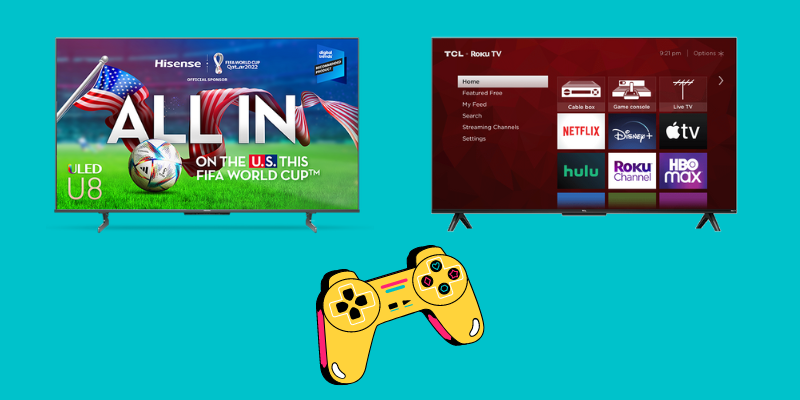
Being a gamer, I prefer to buy a TV that doesn’t only focus on streaming movies and TV shows but also focuses on gaming features. And I am not talking about basic gaming; I am talking about hardcore gaming features that are necessary for today’s market.
Let’s have a deep dive.
1. Refresh Rate
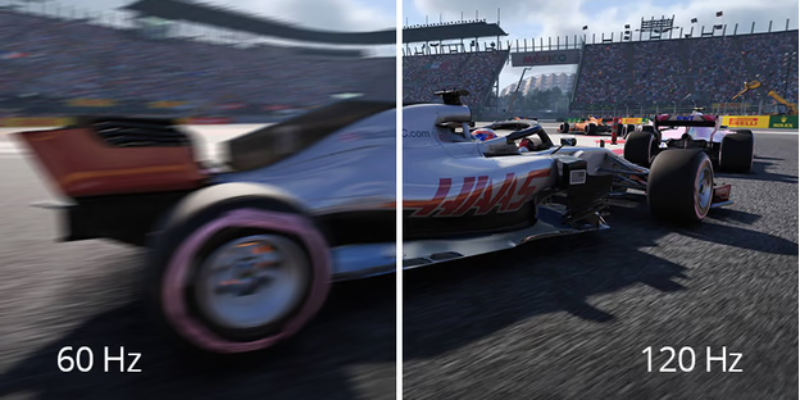
Refresh rate measures how often your TV screen updates its image.
There is a wide range of refresh rates for high-refresh-rate TVs, with 120Hz being a significant upgrade over 60Hz TVs being a popular high-end option.
Both Hisense and TCL offer 4K televisions with 120 Hz refresh rates.
2. Input Lag
The time it takes for a frame to be sent from your TV’s GPU to your TV and then displayed on your screen is known as input lag or display lag. (An input lag of 16ms or less on a 60Hz display is ideal for gaming.)
With a TV that has reduced input latency, you may gain a significant advantage in online gaming. It’s how long it takes for the screen to update when you make a selection or enter text.
Again, the figures are pretty close, but TCL triumphs because of the smaller input lag. An affordable TCL TV is an excellent choice for serious gamers.
3. Motion Handling

Motion handling is labeled as “Motion Rate” on Hisense and TCL product catalogs.
The higher the Motion Rate, the higher the native refresh rate, so a Motion Rate of 240 indicates a 120Hz refresh and a Motion Rate of 120 indicates a 60Hz refresh. A Motion Rate of 60 also indicates a refresh rate of 60 hertz (Hz) on their entry-level TVs.
If you’re looking to compare Hisense and TCL TVs, you’ll find that TCL TVs have smoother motion and less judder overall.
4. Response Time
The time required for a pixel to transition from one color to another (black to white or vice versa) is known as its response time.
Although it is not the sole component, it significantly affects how motion blur is perceived. If your tv takes a noticeable time to change the colors, you will feel ghosting.
NOTE
Ghosting occurs when an image artifact appears as a pixel trail or as ghosts behind fast-moving objects. Visual ghosting is common when playing an FPS (Call of Duty) or a Fast-paced (Need for Speed) sports game.
TCL TVs are often faster than Hisense TVs. Typically, the time gap is on the order of milliseconds. However, motion blur, ghosting, and other anomalies are highly improbable on a TCL TV.
Most TCL TVs in entry-level or mid-level zones offer response times of 6.5ms, while the Hisense offers 10ms. Though in the premium category, the Hisense OLED TVs offer a response time of 1ms, making them an incredibly great choice for gamers.
Price Comparison
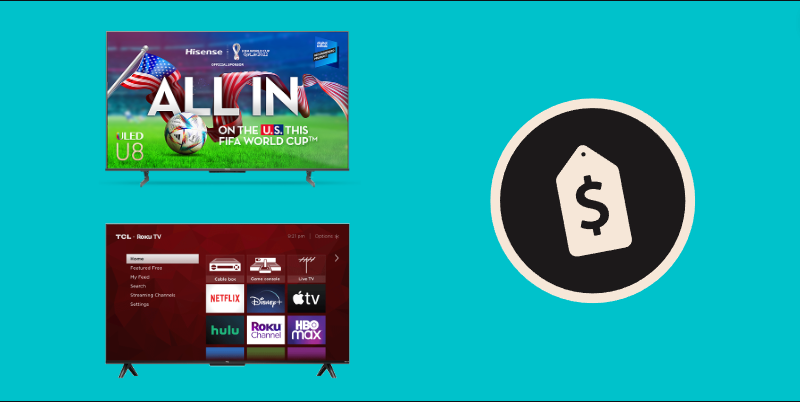
When it comes to price, TCL tends to be slightly more affordable compared to Hisense. Let me explain with an example:
At the time of writing this guide, I searched for a TV on Amazon within a budget of $400-$450.
- Hisense: Hisense currently offers a 50-inch QLED UHD 4K model (50U6HF) for $429.99.
- TCL: TCL currently offers a 55-inch QLED UHD 4K model (55S546) for $419.99.
TCL provides 224 sq. in. more screen size at an even lesser price, and all of the specs are pretty similar, making it more affordable than a Hisense TV.
Conclusion
To conclude, comparing Hisense vs. TCL, TCL is better than Hisense in entry-level and mid-range brackets, while Hisense is miles ahead in the premium category.
TCL TVs are faster and more responsive because of a clutter-free and straightforward user interface. The screen panel provides better color accuracy and clarity on TCL TVs. Also, when it comes to gaming, TCL is a better choice.
At the same time, Hisense TVs provide better daytime brightness, better black levels, and local dimming.
To find your best TV, compare a Hisense TV and a TCL TV within your budget, thoroughly examine their demo units, and then make your choice!
With that said, Hisense TVs aren’t terrible; they make some excellent models. TCL’s models have a slight upper hand in several important respects.

